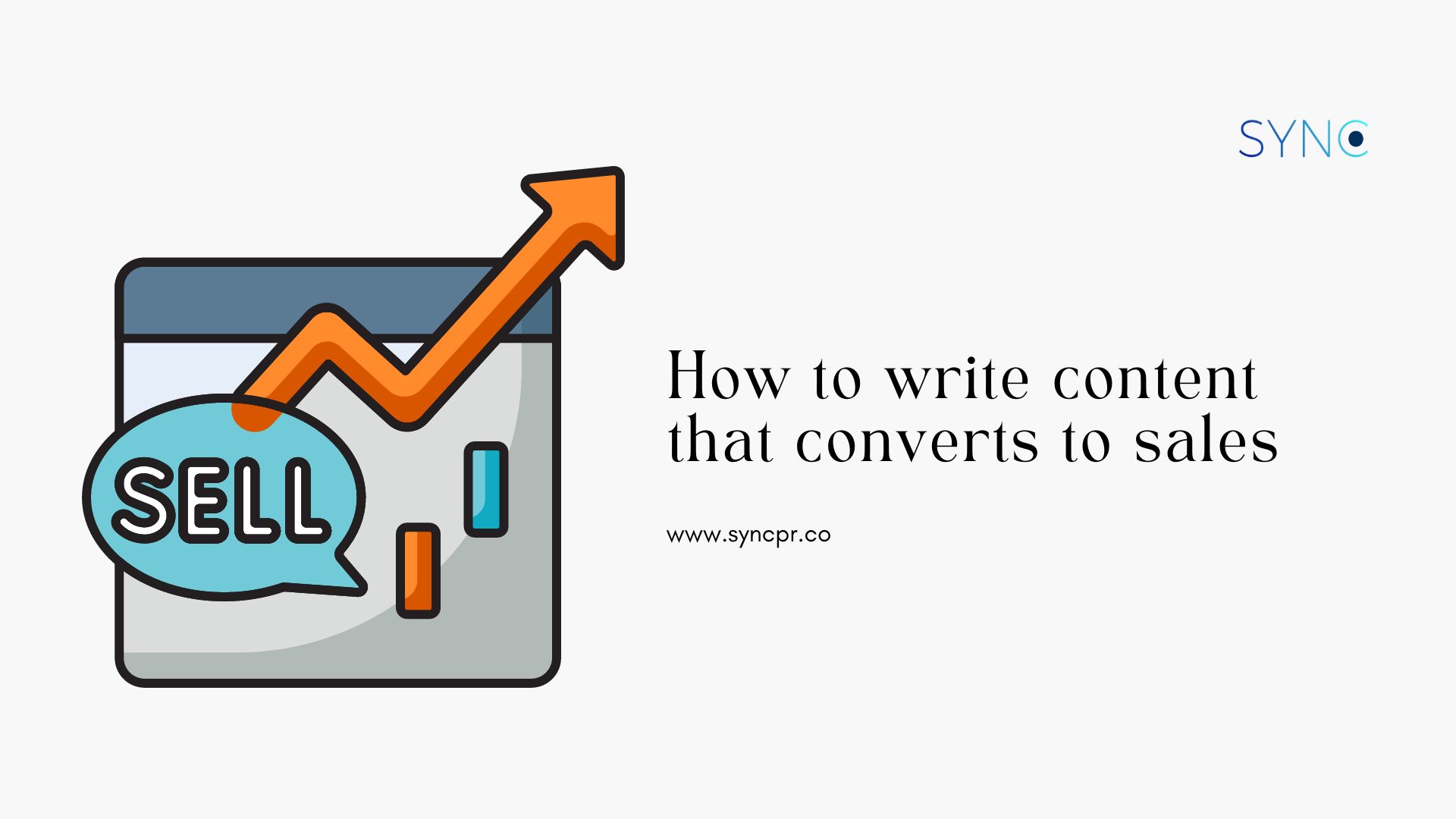As an entrepreneur, your ultimate goal is most likely to generate sales and revenue for your company. Content marketing, which involves creating and sharing valuable, relevant, and consistent content to attract and retain a clearly defined audience and, ultimately, drive profitable customer action, is one of the most effective ways to achieve this goal. But, how do you write content that converts into actual sales for your business?
READ MORE: Here are 5 steps to building a personal brand as a first-time entrepreneur
When it comes to driving sales and revenue, however, not all content is created equal. To create content that effectively drives sales, you must consider the following factors:
- Understanding your target audience
- Identifying your key message
- Selecting the right format
- Crafting a compelling headline
- Writing persuasive copy
- Including strong calls-to-action
- Measuring and optimizing your results
Let’s dive into each section in detail.
Section 1: Understanding your target audience

Understanding your target audience is critical when it comes to creating content that drives conversions. It’s critical to dig deeper than their demographics to understand their motivations, desires, and pain points. Understanding what motivates them allows you to create content that connects with them on a deeper level and inspires action.
There are several approaches you can take to achieve this level of understanding. Surveys are an excellent way to gather direct feedback from your target audience, whereas customer feedback can provide insight into what they like and dislike about your brand. Social media analytics, on the other hand, can reveal which topics and content types your target audience is most interested in.
You can tailor your content to your target audience’s preferences and needs by using these tools to gain a comprehensive understanding of them. That is why content that converts can help you differentiate yourself from competitors, build a stronger emotional connection with your audience, and ultimately drive more conversions.
Section 2: Identifying your key message
Identifying your key message is critical for creating effective content that resonates with your target audience. Your key message should emphasise the primary benefit of your product or service and how it differs from competitors. It should also address your target audience’s pain points and the problems your product or service solves for them.
Start by analysing your unique value proposition and your brand’s core values to identify your key message. Consider the features and benefits of your product or service, as well as how they solve the problems of your target audience. Consider the language your target audience speaks and the keywords they use when searching online.
You can use your key message to guide the rest of your content creation process once you’ve identified it. All of your content, from blog posts and social media updates to website copy and product descriptions, should include your key message. It should serve as the foundation of your brand messaging, allowing you to communicate the value of your product or service in a way that is appealing to your target audience.
You can build a strong brand identity, establish yourself as an authority in your industry, and drive more conversions by creating content that is focused on your key message. This is why you need to work on creating content that converts well.
READ MORE: Here are 5 reasons why your business should do public relations in Singapore
Section 3: Selecting the right format
Choosing the appropriate content format is an important step in ensuring that your message reaches and engages your intended audience. With so many options available, it’s critical to consider your target audience’s preferences and behaviours, as well as the message you want to convey.
If your target audience consists primarily of busy professionals, they may prefer short, easy-to-digest content, such as social media posts or short videos. A long-form blog post or whitepaper, on the other hand, maybe more appropriate if your audience is looking for in-depth information on a specific topic.
In addition to thinking about your target audience, think about the format that will best showcase your product or service. If you’re selling a physical product, for example, a video or infographic may be the best way to highlight its features and benefits. If you’re selling a service, a case study or testimonial may be more effective in demonstrating the value that your service provides.
Finally, the format you select should be consistent with your overall content marketing strategy and the primary message you want to convey. By choosing the right content format, you can ensure that your message is delivered in a way that resonates with your target audience and best represents your product or service and ultimately drives more conversions.
Section 4: Crafting a great headline

A compelling headline is an important step in content creation because it is the first thing your target audience will see. A great headline can pique their interest and entice them to continue reading. A weak or uninteresting headline, on the other hand, may cause them to skip over your content entirely.
To create a headline that truly connects with your target audience uses strong language and try to elicit an emotional response. This can be accomplished by addressing their concerns or desires, making bold claims or promises, or employing powerful words that elicit action.
It’s critical to test different headline variations to see what resonates best with your target audience. This can be accomplished through A/B testing or by analysing the performance of various headlines across social media platforms or email marketing campaigns.
By creating a compelling headline, you can increase the likelihood of your target audience engaging with your content, which can lead to increased conversions and brand loyalty.
Section 5: Writing persuasive copy for your audience

Writing persuasive copy is an important part of producing effective content that resonates with your target audience. While emphasising the benefits of your product or service, your copy should be informative, engaging, and easy to read.
To accomplish this, use a conversational tone and avoid jargon or technical language that may confuse your audience. Instead, strive to communicate your message in clear, simple, and understandable language. This can aid in the development of a bond between your brand and your target audience, leading to increased engagement and conversions.
Your copy should be compelling and informative, as well as clear and easy to understand. Storytelling is one effective method for accomplishing this. Writing content that converts into sales isn’t rocket science, but you need to be able to craft a real story.
Another important aspect of persuasive copywriting is emphasising the benefits of your product or service rather than its features. You can help your audience see the value in what you’re offering and encourage them to take action by emphasising the ways in which your product or service can make their lives easier, more enjoyable, or more fulfilling.
Overall, persuasive copywriting requires a combination of clarity, engagement, and storytelling, along with a focus on the benefits of your product or service. You can create content that resonates with your audience and inspires them to take action by following these guidelines.
READ MORE: Have you ever wondered what is PR all about?
Section 6: Including strong Calls-to-Action (CTA)
In order to drive engagement and conversions, you must include strong calls-to-action (CTAs) in your content. Your CTA should be clear, concise, and compelling, and it should explain what you want your audience to do next.
Using action-oriented language that makes it clear what action you want your audience to take is one effective way to create strong CTAs. You could, for example, use language like “Join now,” “Subscribe today,” or “Start your free trial.” This type of language can help to create urgency and encourage your audience to act.
In addition to using action-oriented language, make it simple for your audience to take the next step. This could include including a clear and visible button or link that leads them to the next stage of the conversion process, such as a sign-up form or landing page.
Personalization is another important aspect of effective CTAs. You can create a more compelling message that will resonate with your audience if you tailor your CTAs to their specific needs and interests. This could include using personalised language, such as “Get your personalised recommendations now,” or emphasising specific benefits that apply to different segments of your audience.
Finally, including strong CTAs in your content is an important step towards increasing engagement and conversions. You can create compelling CTAs that inspire your audience to take action by using action-oriented language, making it easy for your audience to take the next step, and personalising your message.
Section 7: Measuring and optimizing your results

Measuring and optimising your content is an important step towards improving your content strategy and getting better results. By tracking the performance of your content with analytics tools, you can gain valuable insights into what is working well and what needs to be improved.
Tracking engagement metrics such as click-through rates, bounce rates, and time on the page is one way to measure the effectiveness of your content. These metrics can help you understand how well your audience engages with your content and identify areas for improvement.
Conversion rates are another important metric to monitor. You can determine how effective your content is at driving sales and revenue by tracking how many of your visitors take the desired action, such as making a purchase or filling out a form.
After you’ve identified areas for improvement, try out different formats, headlines, and CTAs to see what works best for your audience. A/B testing can be a powerful tool for experimenting with different variations of your content and determining what resonates with your target audience.
Finally, by continuously measuring and optimising your content, you can improve your strategy and conversion rates over time. You can create content that effectively drives sales and revenue for your business by following the steps outlined in this article.
We can help your write content that converts
If you are interested in finding out how to write sales content or at least, content that converts on your website, you can subscribe to our blog and learn more about content marketing and PR. If you feel like you need some help, reach out to us at hello(@)syncpr.co and one of our consultants will get back to you.
If you have time, don’t forget to subscribe to our YouTube channel and check out our series of interviews with marketers, communicators and entrepreneurs around Southeast Asia on marketing without the fluff.

